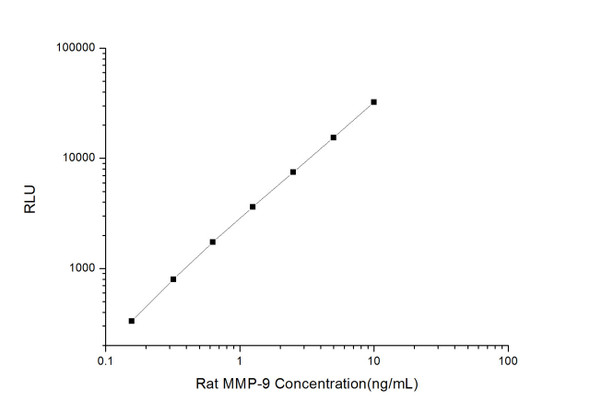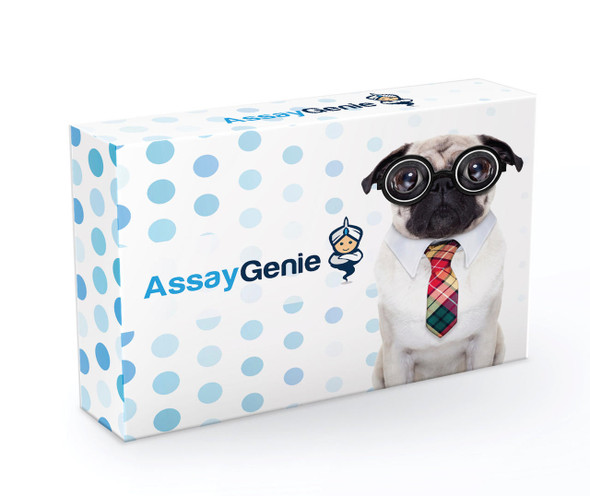Human Cell Biology ELISA Kits 5
Human MMP-9 (Matrix Metalloproteinase 9) CLIA Kit (HUES00828)
- SKU:
- HUES00828
- Product Type:
- ELISA Kit
- ELISA Type:
- CLIA Kit
- Size:
- 96 Assays
- Sensitivity:
- 37.5pg/mL
- Range:
- 62.5-4000pg/mL
- ELISA Type:
- Sandwich
- Synonyms:
- MMP9, CLG4B,Gelatinase B, GELB, MANDP2, 92kDa Type IV Collagenase, 92 KDa Gelatinase
- Reactivity:
- Human
- Sample Type:
- Serum, plasma and other biological fluids
- Research Area:
- Cell Biology
Description
| Assay type: | Sandwich |
| Format: | 96T |
| Assay time: | 4.5h |
| Reactivity: | Human |
| Detection method: | Chemiluminescence |
| Detection range: | 62.50-4000 pg/mL |
| Sensitivity: | 37.50 pg/mL |
| Sample volume: | 100µL |
| Sample type: | Serum, plasma and other biological fluids |
| Repeatability: | CV < 15% |
| Specificity: | This kit recognizes Human MMP-9 in samples. No significant cross-reactivity or interference between Human MMP-9 and analogues was observed. |
This kit uses Sandwich-CLIA as the method. The micro CLIA plate provided in this kit has been pre-coated with an antibody specific to Human MMP-9. Standards or samples are added to the appropriate micro CLIA plate wells and combined with the specific antibody. Then a biotinylated detection antibody specific for Human MMP-9 and Avidin-Horseradish Peroxidase (HRP) conjugate are added to each micro plate well successively and incubated. Free components are washed away. The substrate solution is added to each well. Only those wells that contain Human MMP-9, biotinylated detection antibody and Avidin-HRP conjugate will appear fluorescence. The Relative light unit (RLU) value is measured spectrophotometrically by the Chemiluminescence immunoassay analyzer. The RLU value is positively associated with the concentration of Human MMP-9. The concentration of Human MMP-9 in the samples can be calculated by comparing the RLU of the samples to the standard curve.
| UniProt Protein Function: | MMP9: May play an essential role in local proteolysis of the extracellular matrix and in leukocyte migration. Could play a role in bone osteoclastic resorption. Cleaves KiSS1 at a Gly-|-Leu bond. Cleaves type IV and type V collagen into large C-terminal three quarter fragments and shorter N-terminal one quarter fragments. Degrades fibronectin but not laminin or Pz-peptide. Exists as monomer or homodimer; disulfide-linked. Exists also as heterodimer with a 25 kDa protein. Macrophages and transformed cell lines produce only the monomeric form. Interacts with ECM1. Activated by 4-aminophenylmercuric acetate and phorbol ester. Up-regulated by ARHGEF4, SPATA13 and APC via the JNK signaling pathway in colorectal tumor cells. Produced by normal alveolar macrophages and granulocytes. Inhibited by histatin-3 1/24 (histatin-5). Inhibited by ECM1. Belongs to the peptidase M10A family. |
| UniProt Protein Details: | Protein type:Protease; Secreted, signal peptide; Secreted; Motility/polarity/chemotaxis; EC 3. 4. 24. 35 Chromosomal Location of Human Ortholog: 20q13. 12 Cellular Component: extracellular space; proteinaceous extracellular matrix; extracellular region Molecular Function:collagen binding; identical protein binding; protein binding; zinc ion binding; metalloendopeptidase activity; endopeptidase activity Biological Process: positive regulation of keratinocyte migration; extracellular matrix disassembly; collagen catabolic process; axon guidance; extracellular matrix organization and biogenesis; ossification; macrophage differentiation; positive regulation of apoptosis; ephrin receptor signaling pathway; proteolysis; leukocyte migration; skeletal development; embryo implantation Disease: Metaphyseal Anadysplasia 2 |
| NCBI Summary: | Proteins of the matrix metalloproteinase (MMP) family are involved in the breakdown of extracellular matrix in normal physiological processes, such as embryonic development, reproduction, and tissue remodeling, as well as in disease processes, such as arthritis and metastasis. Most MMP's are secreted as inactive proproteins which are activated when cleaved by extracellular proteinases. The enzyme encoded by this gene degrades type IV and V collagens. Studies in rhesus monkeys suggest that the enzyme is involved in IL-8-induced mobilization of hematopoietic progenitor cells from bone marrow, and murine studies suggest a role in tumor-associated tissue remodeling. [provided by RefSeq, Jul 2008] |
| UniProt Code: | P14780 |
| NCBI GenInfo Identifier: | 269849668 |
| NCBI Gene ID: | 4318 |
| NCBI Accession: | P14780. 3 |
| UniProt Secondary Accession: | P14780,Q3LR70, Q8N725, Q9H4Z1, Q9UCJ9, Q9UCL1, Q9UDK2 B2R7V9, |
| UniProt Related Accession: | P14780 |
| Molecular Weight: | 78,458 Da |
| NCBI Full Name: | Matrix metalloproteinase-9 |
| NCBI Synonym Full Names: | matrix metallopeptidase 9 (gelatinase B, 92kDa gelatinase, 92kDa type IV collagenase) |
| NCBI Official Symbol: | MMP9 |
| NCBI Official Synonym Symbols: | GELB; CLG4B; MMP-9; MANDP2 |
| NCBI Protein Information: | matrix metalloproteinase-9; 92 kDa gelatinase; type V collagenase; macrophage gelatinase; 92 kDa type IV collagenase; matrix metalloproteinase 9 (gelatinase B, 92kDa gelatinase, 92kDa type IV collagenase) |
| UniProt Protein Name: | Matrix metalloproteinase-9 |
| UniProt Synonym Protein Names: | 92 kDa gelatinase; 92 kDa type IV collagenase; Gelatinase B; GELB |
| Protein Family: | Matrix metalloproteinase |
| UniProt Gene Name: | MMP9 |
| UniProt Entry Name: | MMP9_HUMAN |
As the RLU values of the standard curve may vary according to the conditions of the actual assay performance (e. g. operator, pipetting technique, washing technique or temperature effects), the operator should establish a standard curve for each test. Typical standard curve and data is provided below for reference only.
| Concentration (pg/mL) | RLU | Average | Corrected |
| 4000 | 56427 61735 | 59081 | 59046 |
| 2000 | 27704 28014 | 27859 | 27824 |
| 1000 | 14073 12895 | 13484 | 13449 |
| 500 | 6068 7142 | 6605 | 6570 |
| 250 | 3252 3234 | 3243 | 3208 |
| 125 | 1605 1557 | 1581 | 1546 |
| 62.50 | 730 780 | 755 | 720 |
| 0 | 35 35 | 35 | -- |
Precision
Intra-assay Precision (Precision within an assay): 3 samples with low, mid range and high level Human MMP-9 were tested 20 times on one plate, respectively.
Inter-assay Precision (Precision between assays): 3 samples with low, mid range and high level Human MMP-9 were tested on 3 different plates, 20 replicates in each plate.
| Intra-assay Precision | Inter-assay Precision | |||||
| Sample | 1 | 2 | 3 | 1 | 2 | 3 |
| n | 20 | 20 | 20 | 20 | 20 | 20 |
| Mean (pg/mL) | 220.89 | 625.04 | 1419.98 | 223.42 | 687.02 | 1340.57 |
| Standard deviation | 20.76 | 47.38 | 127.09 | 23.59 | 74.54 | 142.37 |
| C V (%) | 9.40 | 7.58 | 8.95 | 10.56 | 10.85 | 10.62 |
Recovery
The recovery of Human MMP-9 spiked at three different levels in samples throughout the range of the assay was evaluated in various matrices.
| Sample Type | Range (%) | Average Recovery (%) |
| Serum (n=5) | 98-112 | 104 |
| EDTA plasma (n=5) | 92-109 | 99 |
| Cell culture media (n=5) | 102-116 | 107 |
Linearity
Samples were spiked with high concentrations of Human MMP-9 and diluted with Reference Standard & Sample Diluent to produce samples with values within the range of the assay.
| Serum (n=5) | EDTA plasma (n=5) | Cell culture media (n=5) | ||
| 1:2 | Range (%) | 97-114 | 101-116 | 89-104 |
| Average (%) | 105 | 108 | 95 | |
| 1:4 | Range (%) | 96-110 | 95-108 | 89-106 |
| Average (%) | 102 | 103 | 97 | |
| 1:8 | Range (%) | 91-103 | 87-100 | 86-97 |
| Average (%) | 97 | 92 | 91 | |
| 1:16 | Range (%) | 93-106 | 96-112 | 91-104 |
| Average (%) | 98 | 104 | 98 |
An unopened kit can be stored at 4°C for 1 month. If the kit is not used within 1 month, store the items separately according to the following conditions once the kit is received.
| Item | Specifications | Storage |
| Micro CLIA Plate(Dismountable) | 8 wells ×12 strips | -20°C, 6 months |
| Reference Standard | 2 vials | |
| Concentrated Biotinylated Detection Ab (100×) | 1 vial, 120 µL | |
| Concentrated HRP Conjugate (100×) | 1 vial, 120 µL | -20°C(shading light), 6 months |
| Reference Standard & Sample Diluent | 1 vial, 20 mL | 4°C, 6 months |
| Biotinylated Detection Ab Diluent | 1 vial, 14 mL | |
| HRP Conjugate Diluent | 1 vial, 14 mL | |
| Concentrated Wash Buffer (25×) | 1 vial, 30 mL | |
| Substrate Reagent A | 1 vial, 5 mL | 4°C (shading light) |
| Substrate Reagent B | 1 vial, 5 mL | 4°C (shading light) |
| Plate Sealer | 5 pieces | |
| Product Description | 1 copy | |
| Certificate of Analysis | 1 copy |
- Set standard, test sample and control (zero) wells on the pre-coated plate and record theirpositions. It is recommended to measure each standard and sample in duplicate. Note: addall solutions to the bottom of the plate wells while avoiding contact with the well walls. Ensuresolutions do not foam when adding to the wells.
- Aliquot 100µl of standard solutions into the standard wells.
- Add 100µl of Sample / Standard dilution buffer into the control (zero) well.
- Add 100µl of properly diluted sample (serum, plasma, tissue homogenates and otherbiological fluids. ) into test sample wells.
- Cover the plate with the sealer provided in the kit and incubate for 90 min at 37°C.
- Aspirate the liquid from each well, do not wash. Immediately add 100µL of BiotinylatedDetection Ab working solution to each well. Cover the plate with a plate seal and gently mix. Incubate for 1 hour at 37°C.
- Aspirate or decant the solution from the plate and add 350µL of wash buffer to each welland incubate for 1-2 minutes at room temperature. Aspirate the solution from each well andclap the plate on absorbent filter paper to dry. Repeat this process 3 times. Note: a microplatewasher can be used in this step and other wash steps.
- Add 100µL of HRP Conjugate working solution to each well. Cover with a plate seal andincubate for 30 min at 37°C.
- Aspirate or decant the solution from each well. Repeat the wash process for five times asconducted in step 7.
- Add 100µL of Substrate mixture solution to each well. Cover with a new plate seal andincubate for no more than 5 min at 37°C. Protect the plate from light.
- Determine the RLU value of each well immediately.






